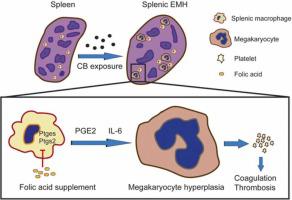Journal of Hazardous Materials ( IF 13.6 ) Pub Date : 2021-09-27 , DOI: 10.1016/j.jhazmat.2021.127354 Qingtao Meng 1 , Bin Li 2 , Nannan Huang 3 , Shengnan Wei 3 , Quanzhong Ren 1 , Shenshen Wu 1 , Xiaobo Li 2 , Rui Chen 4

|
Due to its wide applications in tire and rubber products, carbon black (CB) implicates concerns on its safety during production, collection, and handling. Here we report that exposure CB, increases coagulation-thrombosis potential in a splenic extramedullary hemopoiesis (EMH)-dependent manner. Adult C57BL/6 mice are kept in whole-body inhalation chambers, and exposed to filtered room air (FRA) or CB for 28 consecutive days. CB exposure resulted in splenic EMH characterized with platelet precursor cells, megakaryocytes (MKs), hyperplasia and enhanced in vivo blood coagulation ability. Metabolomics analysis suggests significant enhance in PGE2 production but reduction in folic acid (FA) levels in murine serum following CB exposure. Mechanistically, activation of COX-dependent PGE2 production promotes IL-6 expression in splenic macrophages, which subsequently results in splenic EMH and increased platelet counts in circulation. Administration of FA protects the mice against CB-induced splenic EMH through inhibiting prostaglandin-endoperoxide synthase 2 (Ptgs2 or Cox2) and prostaglandin E synthase (Ptges) expression in splenic macrophages, eventually recover the coagulation capacity to normal level. The results strongly suggest the involvement of splenic EMH in response to CB exposure and subsequently increased coagulation-thrombosis potential. Supplementation with FA may be a candidate to prevent thrombosis potential attributable to CB exposure.
中文翻译:

叶酸靶向脾髓外造血以减弱炭黑诱导的凝血-血栓形成潜力
由于其在轮胎和橡胶产品中的广泛应用,炭黑 (CB) 在生产、收集和处理过程中涉及其安全性问题。在这里,我们报告暴露 CB,以脾髓外造血 (EMH) 依赖性方式增加凝血-血栓形成的可能性。成年 C57BL/6 小鼠被保持在全身吸入室中,并连续 28 天暴露于过滤的室内空气 (FRA) 或 CB。CB 暴露导致脾 EMH 以血小板前体细胞、巨核细胞 (MKs)、增生和体内增强为特征凝血能力。代谢组学分析表明 PGE2 产生显着增加,但在接触 CB 后小鼠血清中的叶酸 (FA) 水平降低。从机制上讲,COX 依赖性 PGE2 生成的激活促进了脾巨噬细胞中 IL-6 的表达,随后导致脾 EMH 和循环中血小板计数增加。FA 通过抑制前列腺素内过氧化物合酶 2( Ptgs2 或 Cox2)和前列腺素 E 合酶(Ptges)保护小鼠免受 CB 诱导的脾 EMH在脾巨噬细胞中表达,最终使凝血能力恢复到正常水平。结果强烈表明脾 EMH 参与响应 CB 暴露和随后增加的凝血-血栓形成潜力。补充 FA 可能是预防因 CB 暴露引起的潜在血栓形成的候选者。



























 京公网安备 11010802027423号
京公网安备 11010802027423号